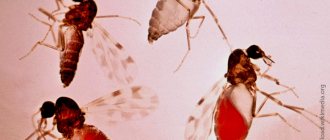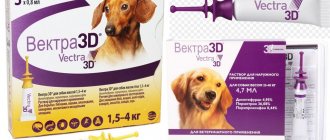Types of vaccines
There are three types of tick vaccinations for dogs, but they all work on the same principle. Each drug contains a small amount of pathogenic intracellular organisms. Name of tick vaccines:
- Nobivac Piro
- Eurican Piro
- Pirodog.
The dog’s immune system fights pathogenic microorganisms that have entered the blood from drugs, producing antibodies to them.
Nobivac Piro
Vaccination for dogs against ticks is produced in the Netherlands by Intervet. The drug contains grafted strains of Babesia A and Babesia rossi. Helps strengthen the body's immune response against the activity of intracellular parasites.
The Nobivak tick vaccination is given to adult animals and puppies over 5 months old. Cannot be used in combination with other vaccines within 2 weeks before and after immunization.
Eurikan Piro
Vaccination against tick-borne encephalitis for dogs in the form of a solution containing red blood cells infected with Babesia canis and treated with gamma rays.
It is these microorganisms that cause canine piroplasmosis, also known as babesiosis. The drug is produced by the French company Merial. It is harmless and, as a rule, does not cause severe side effects.
The development of immunity in animals to pathogens occurs 2 weeks after vaccination. The immune effect lasts for six months.
The dog is vaccinated against encephalitis twice, with an interval of 3-4 weeks.
In rare cases, after taking the drug, pets may experience lethargy and decreased appetite. Such symptoms resolve on their own and do not require therapeutic intervention.
If an allergic reaction occurs, treatment is carried out with antihistamines.
The vaccination is not used against tick bites and does not have a therapeutic effect.
Eurican is allowed to be used with vaccines against rabies and leptospirosis, but only if the injections are administered separately and in different areas of the body.
Pirodog
The vaccine is an analogue of Eurikan Piro, which is also produced by Merial. It has similar composition, indications and side effects.
Can be used without observing the recommended time intervals with vaccinations against leptospirosis and rabies from the same manufacturer.
The best drugs for vaccinations
Today, veterinary medicine most often uses two prophylactic drugs that help fight infections carried by ticks. These medications have different effects on the body, but in both cases the pet begins to produce antibodies that can resist pathogenic bacteria. We are talking about the following vaccines:
- Pirodog (manufactured by Merial), which is blood cells infected with the Babesia canis strain, which are necessarily treated with gamma radiation. This drug includes 2 antigens Ag and RPA (parasitic antigens of a soluble type), which remove the tone from the vascular walls and create a powerful immune complex against the pathogenic pathogen.
- Nobivac-Piro (Intervet) differs from the previous drug in that it is a bivalent type vaccine, designed to combat two main strains that provoke the development of piroplasmosis in domestic animals. Like Pirodog, this drug contains two types of antigens that do not kill pathogenic bacteria, but only reduce their activity, thereby easing the general condition of the pet during infection and significantly accelerating the recovery process.
Both drugs are effective for 12 months, subject to proper vaccination, and this has a certain advantage, because the dog receives reliable protection throughout the year. And if you consider that recently cases of infection of animals have become more frequent even in the cold season, then such prevention is indeed very important.
Preparatory measures
Before vaccinating a dog against ticks, anthelmintic measures are carried out 2 weeks before the intended procedure. It is also necessary to carry out treatment against entomoses in the presence of fleas, lice and any other ectoparasites in the animal.
Before vaccination, the pet must be examined by a veterinarian. It is also recommended to take a blood test to eliminate the risk of inflammatory processes and Babesia microorganisms in the animal.
What to do if you notice a tick on your dog?
As the veterinarian notes, ticks often cling to dogs, especially long-haired ones. “And then they slowly get to the skin and bite the animal. It is important to monitor the animal's condition every day. If you have removed a tick, then this definitely requires control. Or you need to immediately go and donate blood, and the veterinarian will immediately confirm or deny the presence of blood parasites,” explains Sirotina.
She adds that if you notice any lethargy in an animal, refusal to eat, drowsiness, or a change in behavior, then there is no need to wait, you need to urgently go to the doctor to rule out piroplasmosis.
How to protect your pet from tick bites? More details
“Firstly, in the spring ticks are more angry and very hungry. Secondly, the animal has a seasonal decrease in immunity, therefore vitamin therapy is recommended to be carried out in the spring.
If all these preventive measures are followed, the animal will be protected. Otherwise, not only the animal, but also the person suffers - the pet’s illness takes a lot of time, effort, nerves and money. So it’s better to prevent than to treat later,” the expert concludes.
special instructions
Vaccination against tick-borne encephalitis in animals is carried out only in a veterinary clinic. After the procedure, it is recommended to stay in the hospital for another 20-25 minutes to observe the body’s reaction to the injected drug.
If the pet feels well, then the owner can safely go home with him.
Within 3 days after the tick vaccination has been given, the animal must be given antihistamines prescribed by the doctor.
The pet needs proper rest and nutrition in the first days after the vaccine. It is also important not to overload him with physical activity.
You cannot vaccinate with several types of vaccinations at once, except for those allowed in the instructions for use of the drug. It is recommended to maintain an interval between preventive injections of 3-4 weeks.
When should you start preparing for tick season?
According to the veterinarian, you need to start actively preparing for the spring season while there is still snow - when it melts, all the pathogens are activated.
“The main problem in dogs is piroplasmosis, which is carried by ixodid ticks. The animal is very seriously ill, and if help is not provided in time, it dies. Because of this disease, the dog’s liver and kidneys suffer greatly, and if help is not provided in time, especially if the animal is elderly, the outcome can be fatal,” the expert adds.
Pros and cons of serum
In vaccinated dogs, the consequences of tick bites are much milder or completely asymptomatic. In addition, the vaccine helps prevent the severe consequences of babesiosis (encephalitis).
There are also disadvantages to such vaccinations. Some experts question their effectiveness, since the immune system plays a secondary role when infected with piroplasmosis. The protective functions of the body in this case help reduce the dangerous effects of toxins released by blood parasites.
Among other disadvantages is the high price of drugs. Vaccinating a dog against ticks costs on average 2,500 rubles, excluding the injection by a veterinarian.
Despite this, some experts argue that vaccination is necessary because it reduces the risk of developing encephalitis. Vaccinations are especially necessary for animals living in unfavorable areas where there is a high risk of contracting babesiosis.
Basic concepts about vaccination
The tick bite itself is not so dangerous, because the maximum that it can provoke is an acute allergic reaction, which most often manifests itself in the form of severe itching, swelling and a characteristic rash.
Another thing is that these parasites are carriers of dangerous diseases, among which it is worth highlighting encephalitis, spotted fever, piroplasmosis, etc.
The development of the latter pathology, which occurs very rapidly, is provoked by a certain bacterium called Babesia canis, which has the ability to penetrate the red blood cells of the animal’s plasma and destroy them from the inside. In case of inaction, the dog agonizes for several days after the first symptoms appear, although even timely treatment will not protect the pet from such severe complications as iron deficiency, kidney failure, etc.
That is why veterinarians unanimously recommend that owners vaccinate their dogs, because only after the administration of certain drugs do animals develop the immune defense necessary to resist illnesses. This does not mean that the tick vaccine for dogs is a 100% guarantee against infection, because the risk of infection always remains. But even if this happens, the pet has a much greater chance of a full recovery without dangerous health consequences, despite the prolonged illness.
Period of increased vulnerability
After a tick bite, the first signs of the disease can be seen on the 10th day. Many people think that the faster the bloodsucker is detected and removed from the dog, the less dangerous it is. However, it is not.
For a pet to become ill with tick-borne encephalitis or piroplasmosis, a simple tick bite is enough, and it does not matter how long the parasite remains on the animal’s body - one minute or several days.
The severity of the disease depends on the pet's immunity . Some animals die already on the 3rd day after the bite, some fight the disease for a very long time.
However, you should not rely on Mother Nature, because there is one chance in a thousand for independent recovery. Therefore, at the first bite you need to contact a veterinarian.
You can diagnose piroplasmosis yourself, without a veterinarian. All you need to do is place a drop of your pet’s blood on the glass and smear it. If after a few minutes it spreads across the glass and looks like a net, the dog is sick.
You cannot leave the course of the disease to chance. Need a doctor. Before his arrival, you can give your pet an antipyretic drug, medications for vomiting and diarrhea. You cannot start treatment with folk remedies. The veterinarian will give your dog an injection for tick bites.
To prevent a dog from being bitten by a tick, it is important to follow preventive measures..
- When taking your dog for a walk, it is advisable to avoid places of increased danger: tall grass; it is also undesirable to walk in a birch grove, shaded areas and places with high humidity.
- Low air temperature does not mean that you cannot encounter a tick. At this time, they can become active in sun-warmed areas.
- After walks, you need to monitor your pet daily, because the incubation period of the disease does not appear immediately. If there are visible deviations in the animal’s condition, you should immediately consult a doctor.
- It is important to use protective equipment correctly. It must be remembered that the collar will be effective if it fits tightly to the animal’s skin. The use of sprays and drops does not provide a 100% guarantee, because the bloodsucker dies only after it is saturated with the blood of the pet with the drug. But he still manages to infect the dog.
- The most effective means of protection are tablets. Ticks die immediately after they bite through the pet's skin.
When using medications, it is important to correctly correlate the dosage with the age of the animal.
If a tick bites
Immediately after discovering a blood-sucking insect, it must be removed. It is not advisable to use fatty cream or sunflower oil for these purposes.
Below are several ways to remove a stuck arthropod.
- Using cotton thread. The parasite needs to be surrounded with a thread, as close to its proboscis as possible, twisted and made with the hand with the thread moving in a circle counterclockwise. During movements, you need to slightly pull the thread up. You can't jerk sharply.
- Special devices. The use of special store devices is carried out strictly in accordance with the instructions.
- Tweezers. Grab the parasite closer to the proboscis and try to remove the bloodsucker using circular movements.
After removing the tick, it is recommended to treat the bite site with iodine.
Prevention measures
Even when using vaccines, preventive measures that will reduce the risk of your dog becoming infected with parasites are mandatory. If the animal has access to the outdoors, there is a possibility of fleas.
The most effective methods of prevention are called:
- Drops for dogs. If for some reason the use of a vaccine is excluded, you can choose insecticidal drops. Anti-flea medications classified in this group help quickly destroy parasites and prevent their appearance for several weeks. The use of drops is recommended for the treatment of parasitic infestations in dogs more than eight weeks old.
- Sprays and collars. They can be used separately or in combination with vaccines that have an insecticidal effect only on parasite eggs. Collars contain toxic substances that repel parasites. Aerosols work in a similar way, but they are less convenient to use, since to obtain the desired effect it is necessary to completely treat the dog's fur, which carries the risk of toxic substances entering the animal's digestive tract.
Shampoos can also be used for antiparasitic treatment against fleas. Their action is especially soft and gentle.
The use of shampoo helps care for the animal's fur and relieves the symptoms of flea infestation, that is, itching and skin irritation.
The use of flea shampoos is recommended when giving injections, which only affect parasite eggs. The use of additional means in such cases allows you to rid the animal of skin ectoparasites.
The use of shampoo is especially recommended for removing and preventing the appearance of fleas in puppies less than two months old. Before reaching the specified age level, it is not recommended to vaccinate dogs or use other potent drugs; this can have an extremely negative impact on the puppy’s health.
Should dogs be vaccinated?
Everyone knows how dangerous the bite of an infected tick can be; they can infect an animal with encephalitis, piroplasmosis, Lyme disease and other equally serious diseases. Severe forms of diseases can lead to death, so preventive measures are taken with all responsibility.
Regarding vaccinations and whether to give such an injection to your dog, veterinarians recommend these measures, since they can significantly alleviate the course of the disease and avoid severe forms. Vaccinated animals tolerate the disease much easier, there are no complications or dangerous consequences.
conclusions
- There are no vaccines against tick bites. There are no drugs that would prevent the bite itself.
- There is a vaccine against piroplasmosis. Each owner, together with the veterinarian, makes an individual decision about the need for such a preventive measure for a particular dog, taking into account lifestyle and health status.
- Vaccines against borreliosis exist and are successfully used in Europe and the USA, but in the CIS countries their popularity is low.
- A vaccine has not yet been developed for tick-borne encephalitis. Preventive measures, timely diagnosis and comprehensive treatment of sick animals are of great importance.
- Vaccinations against infections carried by ixodid ticks are given exclusively to healthy animals according to the schedule provided by the manufacturers. All sick animals are subject to specific treatment, and those exposed to tick bites are subject to careful observation for 10-14 days and urgent measures are taken if signs of the disease appear.
- The main prevention of bites and tick-borne diseases remains the treatment of dogs with insectoacaricidal preparations, as well as a thorough examination of the body for the presence of ticks after each walk.
Rate and share!
Guarantee of protection
One of the most common questions asked by dog lovers is whether vaccination provides 100% protection against piroplasmosis.
Unfortunately, today there is no vaccine in the world that could guarantee complete protection against infection with these dangerous diseases.
But despite this, veterinarians still recommend using these preventive measures, since they are the most effective today.
Such an injection allows you to minimize the likelihood of developing severe consequences, which in this case is quite an important point.
Contraindications and side effects
Having figured out when to vaccinate against ticks for dogs, you need to familiarize yourself with the possible complications. After vaccination, a pet may experience persistent low-grade fever (an increase in general body temperature to insignificant levels), malaise, decreased appetite and changes in gait. If such symptoms occur, you should only worry if they last longer than three days.
In such situations, it is urgent to show your pet to a veterinarian, who can prevent further deterioration in the pet’s general condition. Negative manifestations may indicate that infection has already occurred, so a specialist may prescribe additional tests to identify the disease and further develop the most effective treatment regimen.
It is strictly not recommended to vaccinate young pets (up to 5-6 months), pregnant and lactating bitches, as well as weakened animals. The last category may include older dogs that have already begun to undergo decrepit processes, so the issue of vaccinating such pets should be decided on an individual basis, after consulting with several specialists at once.
How to choose a universal drug
Insecticidal agents for subcutaneous administration are selected based on several criteria:
- Degree of flea infestation;
- The presence of other ectoparasites, worms, nematodes of the gastrointestinal tract in the dog;
- The current health status of your four-legged pet;
- Age of the animal.
In Russian veterinary practice, insecticidal preparations with various commercial names are used, however, one way or another they contain one of three components - ivermectin, lufenuron or eprinomectin.
The first is prescribed for the treatment of demodicosis, secondary disposal of lice, lice and fleas.
The second is used as an addition to complex therapy for advanced forms of flea infestations and inhibits the process of degeneration of egg laying into larvae, destroying the chitinous layer of intermediate forms of the insect.
The third is considered universal and is suitable for combating external and internal parasites.
Scheme of administration and indications
The most effective method of vaccination is subcutaneous administration of the drug, which consists of two components: the active substance in dry form and a liquid solvent. Unfortunately, there are certain age limits: vaccines cannot be used until the pet is 5-6 months old.
Naturally, this does not mean that the animal should not receive reliable protection during the designated period, even with the help of less effective means. This list includes special acaricidal sprays, drops intended for application to the withers area and collars with special impregnation. It is worth noting that products and devices can also be used as additional protection for a pet in later life.
Use of subcutaneous vaccine
Before administering the drug to an animal, it must be properly prepared using a syringe and the included solvent. At the same time, you should not shake the bottle to speed up the mixing process, because it should go away on its own within a few minutes. The vaccination scheme itself implies the following procedure and timing:
- Zero or starting vaccination, which is recommended for puppies over six months old 2 months before the start of the warm season.
- On the 18th-42nd day, the second vaccination is carried out (the period depends on the well-being and health status of the animal), which begins to fully act only on the 21st-28th day. During this period, it is recommended to adhere to the general quarantine rules, remembering that the animal is not yet protected.
The duration of action of such drugs can last from 6 to 12 months, after which it is necessary to re-vaccinate to avoid intermediate infection with Babesia canis. The dose of the administered drug should be determined only by a qualified specialist, who will take into account such important indicators as the age and weight of the pet.
Popular questions
How long does the vaccine last? The average duration of action of the active substance may vary. As a rule, vaccinations retain their protective properties for three to six months.
Should my dog be given injections against ectoparasites on an ongoing basis? It is recommended to use medications during periods of risk of dog infection with fleas, in the summer. However, if the animal has constant access to the street, contact with other dogs, it is permissible to use medications that protect against fleas on an ongoing basis.
Will flea injections harm my dog? Vaccinations can only be used as prescribed by a veterinarian. Independent use of any means, regardless of the specifics of their action, can lead to negative consequences. With the correct selection of flea treatment, possible complications are eliminated.
What is the danger of piroplasmosis for dogs?
Canine pyroplasmosis (babesiosis) is a seasonal parasitic blood disease. The disease occurs as a result of the bite of an infected tick. If you suspect that an animal has been affected by it, you should pay attention to the following symptoms:
- change in the dog’s activity (lethargy, weakness);
- increased body temperature;
- change in urine color (darkening to dark brown);
- the appearance of jaundice.
It must be remembered that without proper treatment, animals are doomed to death. Dogs become infected with the pathogen from the bite of a forest tick. This parasite can change three hosts throughout its life cycle. “Hungry” individuals are recognized by color (yellow, yellow-brown, brown-brown). Having found a host and fed on his blood, the tick turns yellow-pink or gray.
Forest ticks are carriers of dangerous diseases
Tick attacks begin during the onset of the first warmth after winter (almost with the melting of snow). Their activity peaks in mid-May and late August, sometimes at the beginning of September. During a bite, a microorganism (the causative agent of piroplasmosis) enters the dog’s blood, which multiplies in the red blood cells of the host animal. The infection period can last from a couple of days to three weeks. The disease occurs with many severe complications associated with different body systems:
- renal failure;
- liver inflammation;
- heart failure;
- anemia.
Only a veterinarian can diagnose piroplasmosis by carefully examining the pet. The main factor for quickly obtaining an appropriate medical opinion is the report of the removal of a tick (one or several) from the dog’s body after a recent walk. An important indicator is the results of urine tests (attention is paid to such features as color, presence and level of hemoglobin, urobilinogen, bilirubin). Parasites can be detected with a special blood test.
Features of treatment of the disease
Piroplasmosis is very difficult to treat. Medicines suitable for use during illness in most cases lead to undesirable effects. The weakened animal’s body has to withstand a double blow: from the waste products of the parasite in the body and from the chemical effects of medications.
What is the procedure for treating piroplasmosis? Firstly, special medications are prescribed that will destroy the infectious agents. Secondly, measures are taken to eliminate the consequences of the harmful activity of the parasite in the body of a sick dog. The selection of optimal auxiliary therapy takes into account the general clinical condition of the injured pet. Veterinarians often use alkalizing diuresis (a procedure necessary to eliminate complications of the disease). After this, specialists prescribe treatment for emerging concomitant ailments.
In advanced cases, elimination of complications of piroplasmosis is delayed and does not always lead to recovery of the pet
A relatively new and effective treatment method is to cleanse the dog’s blood of toxins, damaged proteins and broken red blood cells through filtration (plasmapheresis, hemosorption).
Drops on the withers
Some products also kill fleas, but not all, so read the label carefully. Frontline and Advantage are popular brands. Active ingredients include permethrin, imidacloprid, pyrethrin or fipronil.
Some dogs may experience side effects with this treatment, and many dog owners worry that these medications are toxic and could harm their dogs. If you have these fears, talk to your veterinarian about alternatives that have fewer side effects.
How to give a dog a flea vaccination
It is advisable to administer the insecticide subcutaneously if you have the necessary injection skills. Otherwise, it is recommended to contact a veterinarian. When carrying out the procedure, personal hygiene and safety rules are observed. General scheme:
- Prepare the necessary tools (syringe, insecticide, sterile cotton wool, alcohol), place them in a tray and wash your hands thoroughly.
- Calm the animals and select the injection site.
- Draw the insecticide into a syringe, diluting the solution as necessary with a sufficient amount of distilled water.
- Release excess air from the syringe.
- Disinfect the injection site.
- Take the skin fold at the injection site, insert the needle into their base at an angle of 45 degrees to a depth of 12-15 mm.
- Slowly inject the insecticide while pressing down on the plunger.
- Remove the syringe while holding the needle.
- Apply sterile cotton wool soaked in alcohol to the puncture site.
- Dispose of the tools and seal the bottle with the stopper - it can be stored in the refrigerator for up to 28 days.
Reviews from veterinarians
If you study the reviews of veterinarians, you can make sure that vaccination is still recommended and there are more advantages than disadvantages. Of course, you should always remember about other protective equipment, which are no less important.
During the period when ticks are active, be sure to use sprays, drops, tablets, and collars that will provide protection for your pet and minimize the likelihood of an attack. These vaccinations are especially recommended for those animals that live in areas with an increased risk of infection.
The principle of action of anti-flea injections
The principle of action of flea vaccinations for dogs, regardless of the active substances included in the preparation, is the same - at the moment of a bite, a toxin enters the body of the parasite, which provokes paralysis of the nervous system and subsequent death.
The following feature of the action of injections is interesting: when an insect, into whose body the active substance of the injection has entered, lays eggs, subsequent offspring will not be capable of further life activity. If the flea laid eggs before the bite, the nymphs, that is, the hatched larvae, will be viable until the first meal.
Rules and procedures for vaccination
To achieve the most effective result, you must follow all the rules for vaccinating dogs against ticks, not forgetting such an important point as the preparatory period. This concept implies a certain procedure that must be carried out at least a few weeks before the scheduled vaccination in order to avoid the development of severe complications after the drug is administered. The owner must:
- Show your pet to a specialist for a routine examination and assessment of the current state of its body, since only healthy pets are vaccinated.
- If a dog is diagnosed with any acute or chronic diseases, it will have to be treated, undergo a re-examination and only be vaccinated after two weeks.
- 3-4 weeks before scheduled vaccination, it is necessary to carry out anthelmintic therapy according to a special regimen, since parasitic infestations significantly worsen the general condition of pets, as a result of which vaccination is much more difficult for them to tolerate.
- If the owner planned to breed an animal in the near future, then he will have to abandon this idea, postponing it until better times. As a rule, a bitch can be bred 3-4 weeks after vaccination.
In addition, antihistamine prophylaxis is mandatory, which involves taking antiallergic drugs several days before vaccination. If this procedure is not carried out, it is possible that the animal will develop an acute allergic reaction to the drug and it will be much more difficult for it to survive the vaccination.
Tick-borne encephalitis in dogs: symptoms and treatment
The main symptoms of infection with tick-borne encephalitis and piroplasmosis in a dog include:
- Body temperature up to 40-41 degrees;
- Disinterest in food and water;
- Weakness, problems with coordination;
- Diarrhea and vomiting, sometimes mixed with blood;
- Change in urine color to brown, black or dark green;
- Yellowing of the whites of the eyes;
- Shortness of breath;
- Convulsions;
- Paralysis;
- Apathy, aggression, hyperreactivity or any other nervous state that is strikingly different from the dog’s usual behavior.
These symptoms can appear either progressively depending on the stage of the disease, or spontaneously.
This will depend on the general condition of the dog’s body at the time of the bite. The incubation period for piroplasmosis in dogs lasts from 12 hours to 2 weeks, while the virus can travel from the primary to the severe stage in only 12-24 hours. Intensive treatment in the initial stages takes 1-2 days, plus time is needed for rehabilitation therapy. In advanced cases, it may take from a week to a month. The above-described signs of infection may be a consequence of any other diseases except piroplasmosis, therefore only a doctor should diagnose tick-borne encephalitis in dogs, classify the symptoms and prescribe treatment. To begin with, the clinic will do all the necessary tests and studies to accurately establish the disease, its stage and features of the course. Then the dog must be injected with a special drug that kills the virus cells. Next, a number of medications are prescribed that remove the virus from the body, cleanse and restore damaged organs and systems. Additionally, medications and vitamins are prescribed to support the dog’s body during recovery. Since a lot of active drugs enter the body at this time, this affects primarily the liver and central nervous system.
It is worth adding that treating piroplasmosis and encephalitis in dogs at home without the help of specialists is an extremely dubious undertaking, despite the fact that special antiviral drugs are commercially available. It would never occur to anyone to treat human encephalitis with home injections without preliminary tests. A dog also has one life, so don’t risk it in vain.











